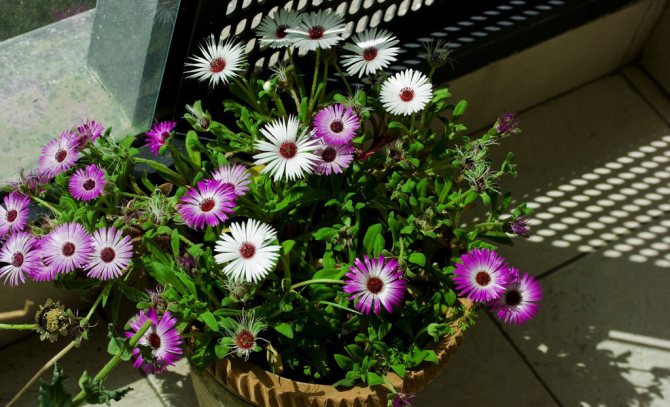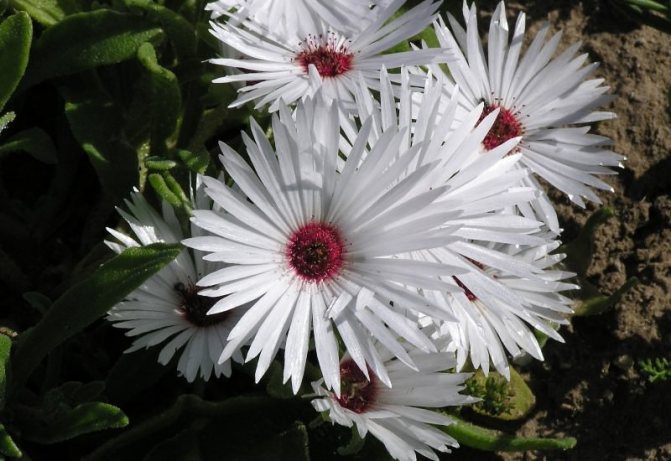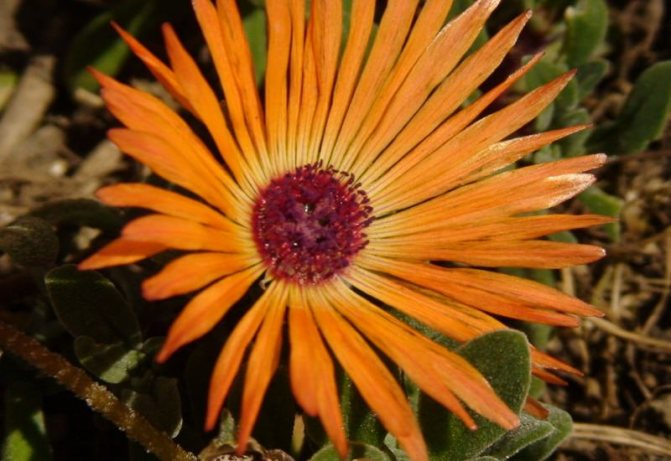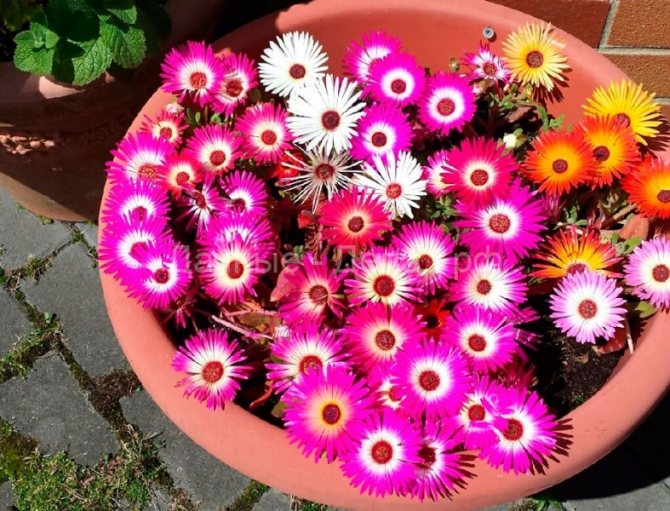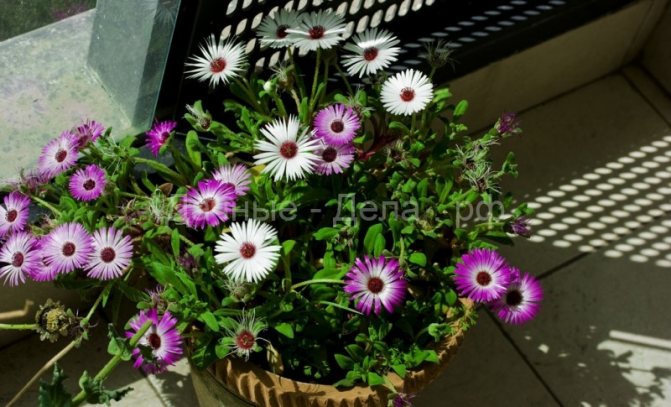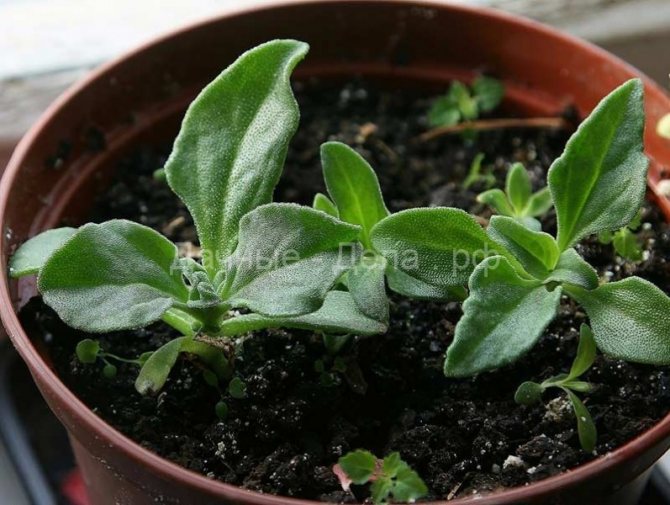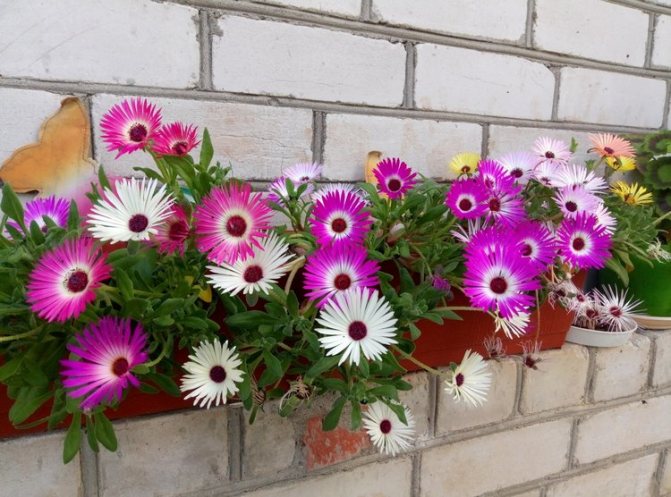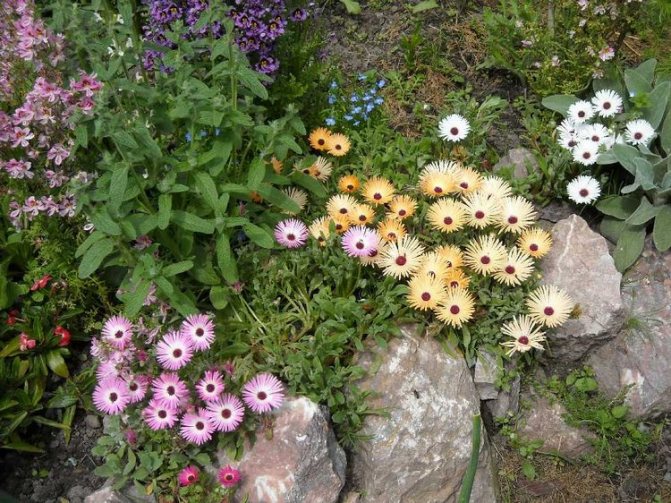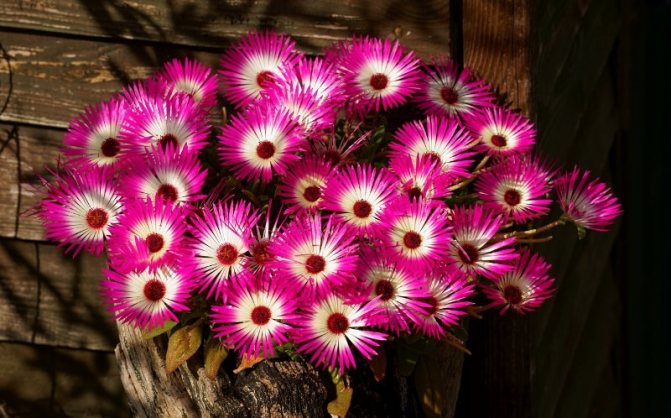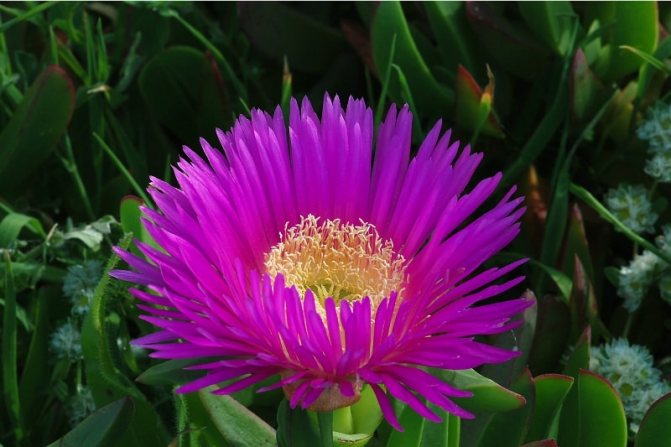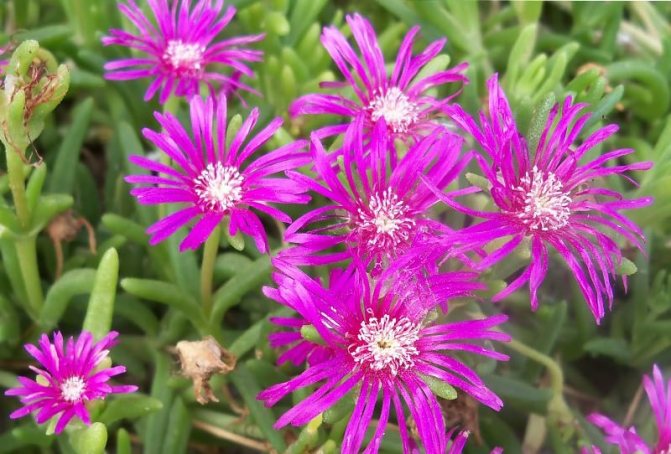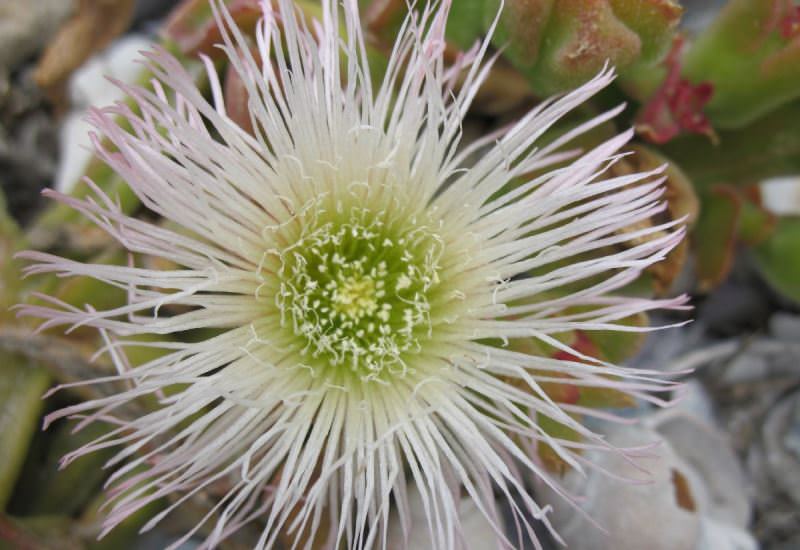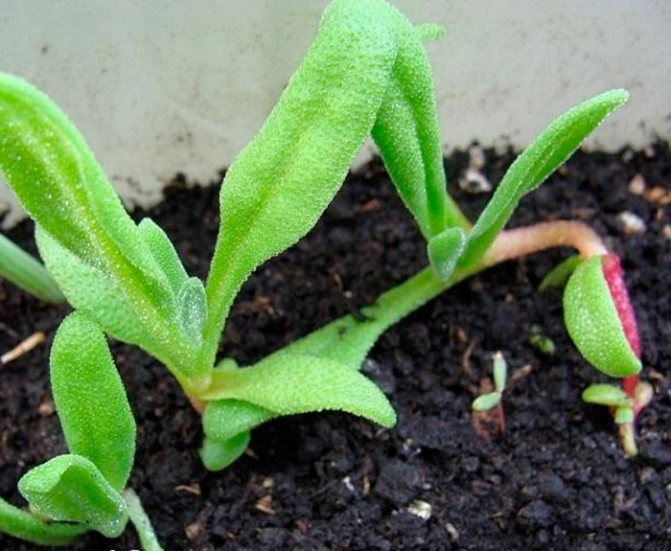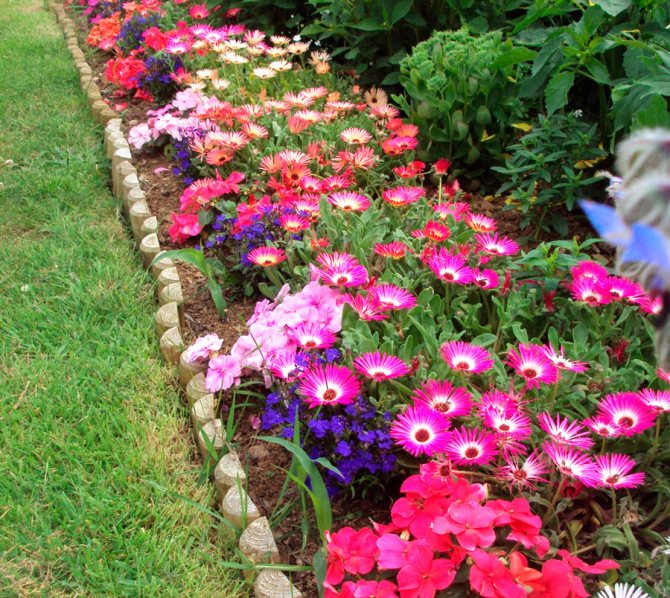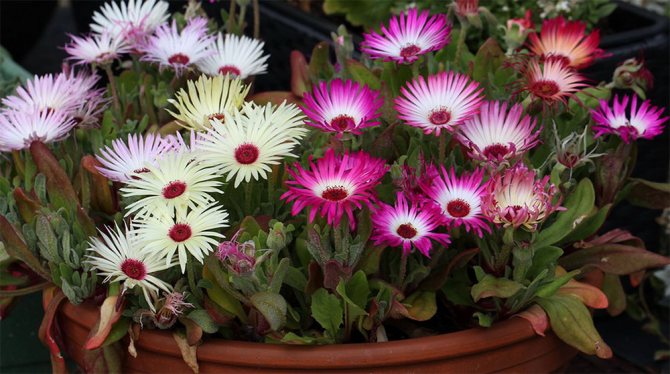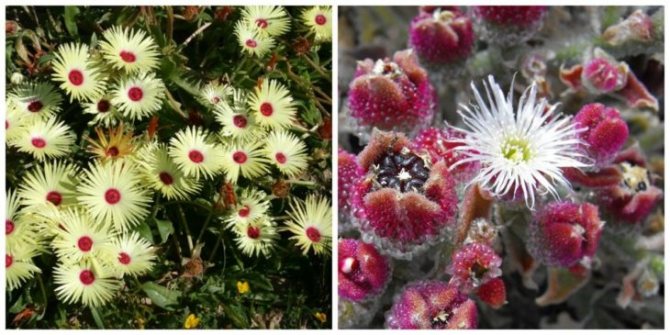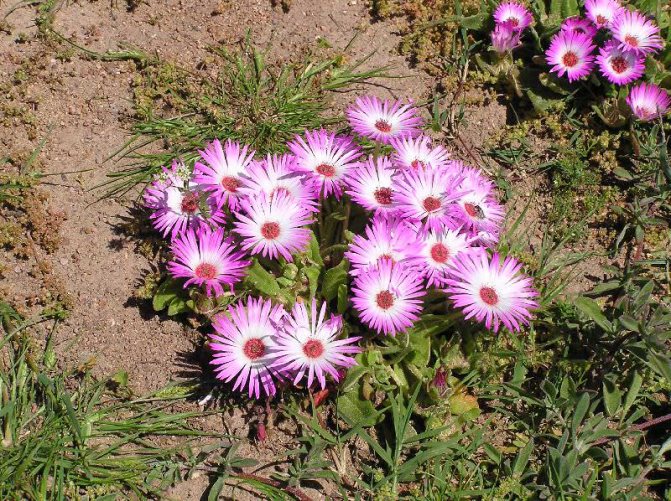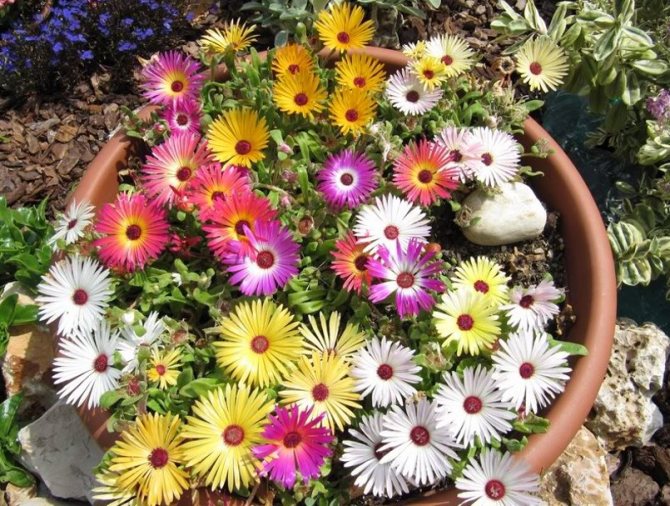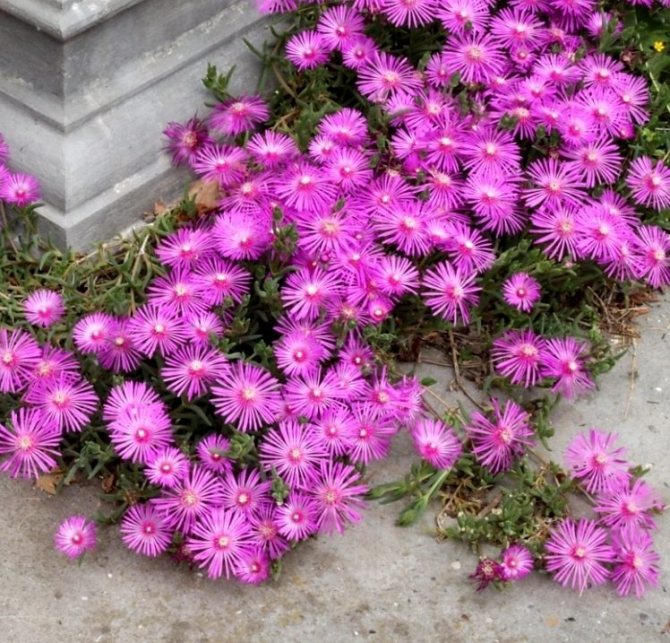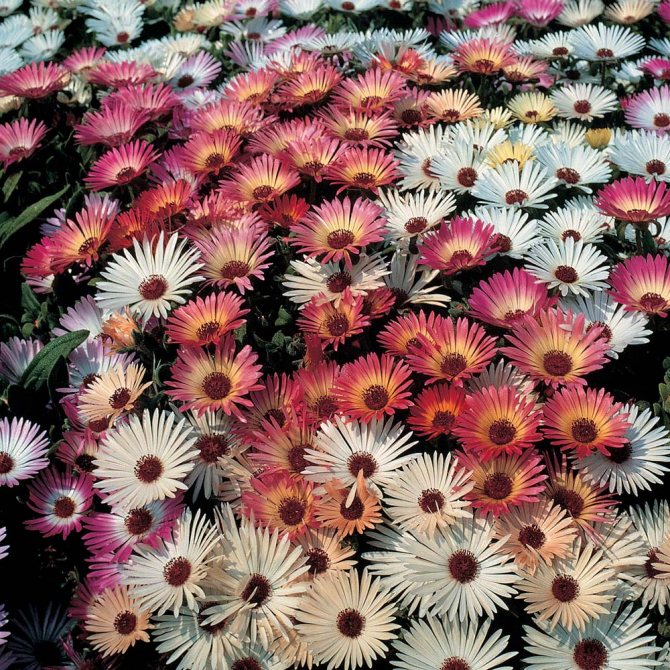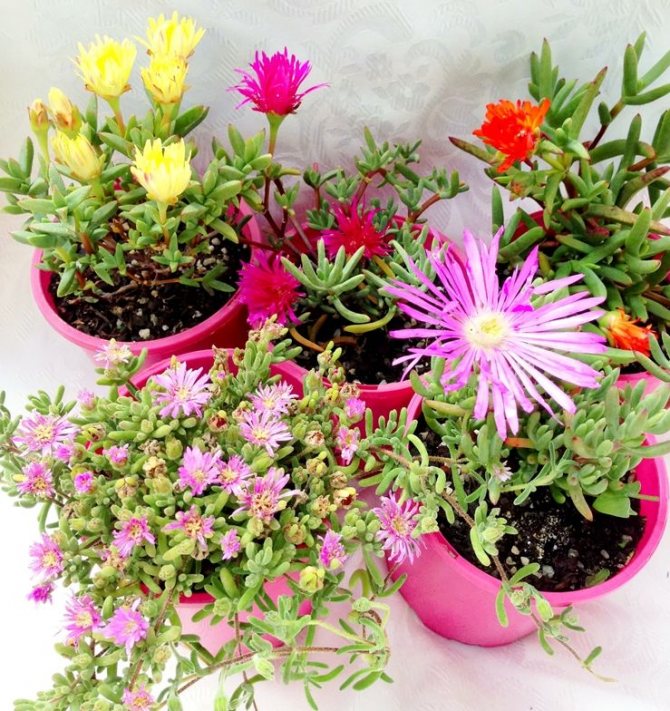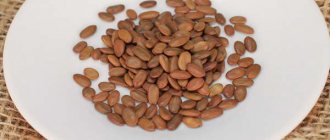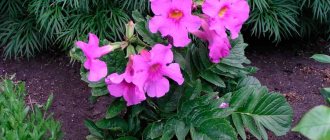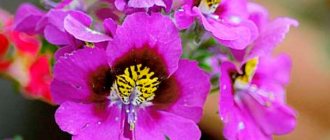Botanical description
The flower stems are diverse: erect or recumbent, creeping, ascending, necessarily thickened, juicy, up to thirty centimeters long. The processes are covered with shiny "cilia". Dense, fleshy leaves have papillae-reservoirs filled with sap, shining in the sun like ice crystals.
How crystal chamomile blooms
Flowers with narrow petals, varied in color - white, pink, red, yellow, purple, lilac. A luxurious green carpet dotted with charming multi-colored flowers looks amazing. The inflorescences are large enough, up to seven centimeters. Bright "suns" are revealed only during the day, in clear weather. In cloudy - only no less interesting leaves will decorate the garden. Flowers with positive energy cheer you up, and the unusual crystal Mesembriantemum consoles with beauty, even when all summer flowers fade.
Further, a fruit resembling a box is formed. There are countless tiny seeds: one gram holds no less than three thousand. Among the many species are perennials and annuals.
general information
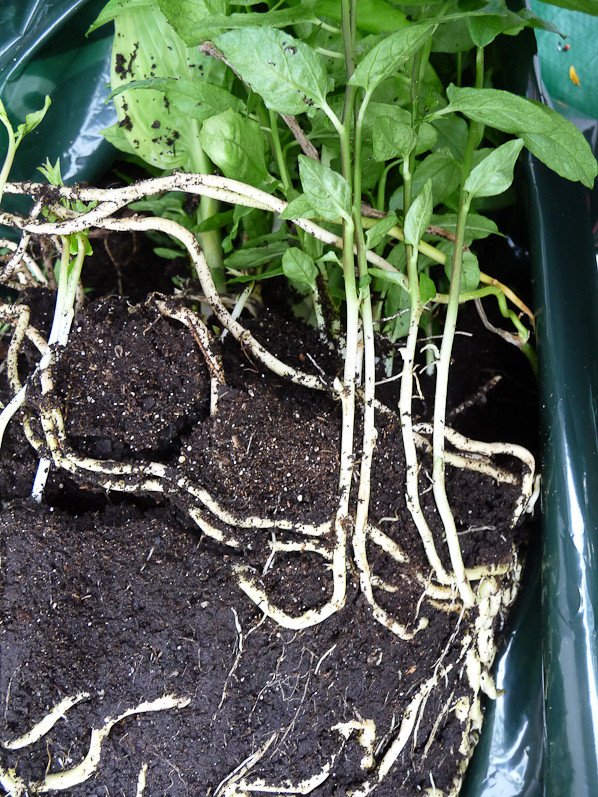
The genus Mesembryanthemum belongs to the Aizaceae family. This name was coined for the plant by Jacob Brein in the 17th century and is derived from two Greek roots meaning "flower" and "noon". It was originally spelled Mesembrianthemum. This name was chosen because the flowers of all plants belonging to this genus known at that time, opened only at noon, in sunny weather. At any other time, for example, at night or in the rain, they closed their petals.
Even in Russian literature, this flower is sometimes, by analogy, called "sunflower" or "midday".
However, already in the 18th century, varieties of this plant were discovered, the flowers of which opened at night. Then the name was slightly corrected by Johan Dillelenius, a botanist from Germany. The Latin name took on a modern look, and the new etymology suggested that it was formed from Greek roots, meaning "middle" and "embryo".
Mesembriantemum is an annual or biennial shrub up to fifteen centimeters high. It is a very short, sometimes creeping or creeping plant. It is classified as a succulent. Its stems usually lie on the ground, but are straight.
The leaves of all representatives are green, large and fleshy. Their distinctive feature is the indispensable presence of swollen cells on the leaves, which resemble crystalline droplets. Such an unusual structure gave this flower another name - "crystal chamomile".
The flowers of this plant can be either single or grow in inflorescences. They are like the flowers of daisies - they have many small, straight and narrow petals... Their colors, as a rule, are red, white or pink, sometimes yellow, but rarely. Small seeds are found in a capsule fruit.
Usually, the main homeland of the mesembryanthemum is called Southeast Africabut it grows in the wild in other places as well: for example, in South Australia, the Mediterranean and the Canary Islands.
Ten rules to help keep a bouquet of roses in a vase longer
Sandy soils bathed in the sun are best suited for this flower.
Growing mesembryanthemum from seeds at home
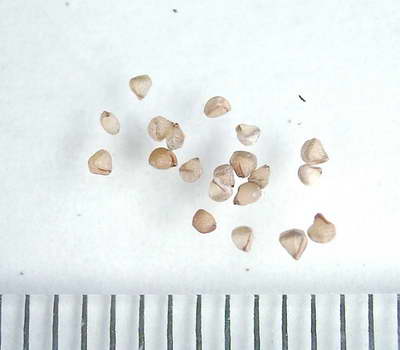

Seeds of mesembryanthemum photo
The cultivation of crystal mesembryanthemum with seeds is popular, since it is impossible to buy seedlings, but getting the seeds is much easier.
A light, loose soil is prepared from a mixture of earth and sand, more sand is taken, and cassettes or seedling boxes are filled.
When to sow mesembriantemum for seedlings
Sow mesembriantemum in late March or early April. Earlier sowing will lead to stretching of seedlings (lack of light affects). Seedlings become brittle, develop poorly.
How to sow
- seeds are scattered over the surface as rarely as possible, it is better to immediately use a toothpick and place them at a distance of 2-3 cm, so that later they do not break through, damaging the roots.
- lightly sprinkle with sand on top;
- the embedment depth does not exceed 2 - 3 mm;
- maintain the temperature + 12-15º C;
- crops are sprayed from a spray gun, covered with a film;
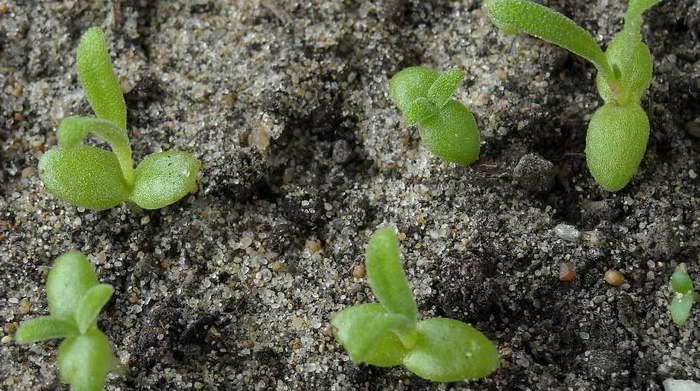

Mesembriantemum growing from seeds photo shoots
- seedlings emerge on the 7-8th day (the main ones - after 21-28 days), then the film is removed, transferred to a light windowsill without drafts;
- too elongated seedlings are treated with retardants, which slows down excessive growth in length and increases cell division of stems in width;
- watered sparingly, avoiding root rot;
- the temperature of the content is reduced to + 10º C;


Seedling mesembryanthemum photo
- grown seedlings, at the stage of appearance of two to four true leaves, dive in separate pots or cassette cells.
- Further care consists in maintaining a moderate moisture content of the substrate, providing bright diffused lighting and a cool temperature of the content in the range of 10-16 ° C.
Reproduction methods
Seeds
The seeds of the mesembryanthemum are very small, 1 g contains about 3 thousand of them. They can be stored for up to 2 years, later the germination rate drops sharply.
Sowing directly into open ground is possible only in the southernmost regions of our country. The seeds are scattered over the surface of the sandy soil, only slightly pressing them into the ground. The ascended plants are thinned out, leaving gaps of 20 - 25 cm between them.
In the middle lane and the Moscow region, mesembriantemum is sown for seedlings in March - April.
For seeds prepare soil from a mixture of sand and turf in a ratio of 2 to 1. The seeds are not buried, but only sprayed with water from a spray bottle. Crops are covered with foil and left to germinate in a warm place. Seedlings appear within three weeks.
Seedlings are placed on the lightest windowsill and kept at a temperature not higher than +12 degrees. Watering is not often, only at the root, with warm water. The mesembriantemum does not tolerate picking well, so it is advisable to sow it in separate pots in several pieces, with the removal of weak plants in the future.
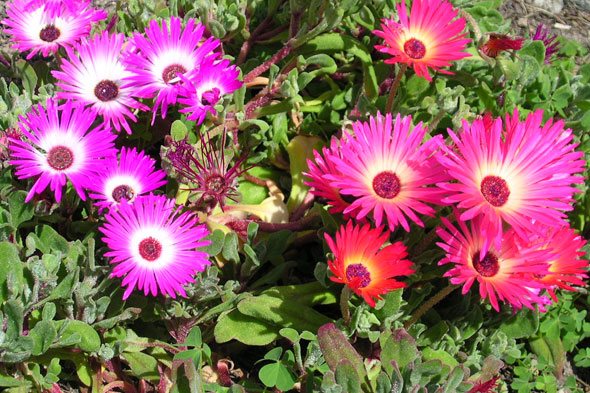

Crystal grass is planted in open ground in May, when the threat of frost passes, and the night temperature stops dropping below +7 degrees. The plant should be placed in sunny areas, it is comfortable for him on the southern slopes. Grows well on poor sandy loam soils with good drainage. Before planting seedlings, you should take care of introducing crushed stone or pebbles into the soil. Thus, you can protect the roots of the plant from excess moisture.
Mesembriantemum is suitable for growing in a pot culture in indoor conditions. The varieties Tigrovy and Bely are suitable for these purposes. The technology of growing a flower at home does not differ from agricultural technology in the open field: you need bright lighting, moderate watering, feeding during flowering and during the dormant period in winter.
Vegetatively
You can propagate the culture by cuttings.To do this, in the autumn, an adult mesembriantemum bush is chosen, dug up and removed to a cool place (with a temperature not higher than +10 degrees) for storage. In the spring, in April, cuttings are cut from the bush and placed in the sand for germination.
The first 3 days they are not watered! Only then slightly moisten the substrate. The appearance of leaves on the cuttings serves as a signal that the roots on the branch have formed, and the planting has taken root.
Young plants are planted in open ground in May, at the same time as seedlings grown from seeds. Mesembriantemum will bloom in mid - late June, and will continuously delight with large bright "daisies" until autumn.
How to plant seedlings of mesembryanthemum in the ground
- planted in open ground in the second decade of May or early June at a constant temperature of at least + 6º C, after the threat of frost passes;
- planting scheme 10x15 cm. For varieties with long shoots - up to 30 cm;
- landing site - sunny, southern slopes.
Crystal mesembriantemum prefers extremely light soil with a weak fertile layer and excellent drainage. To save the stems and leaves from decay, small stones are laid out near the bushes.
Mesembriantemum care, fertilization and feeding
The most important thing in caring for this wondrous flower is to provide a sufficient level of lighting. If the plant lacks light, it will stretch and slow down flowering. With the right lighting, the mesembriantemum blooms very profusely, turning the beds into a multi-colored blooming carpet.
As mentioned above, the plant belongs to succulents, and, like all of them, does not tolerate excess moisture well. If your pet has an excess of water, leave it until it is completely dry.
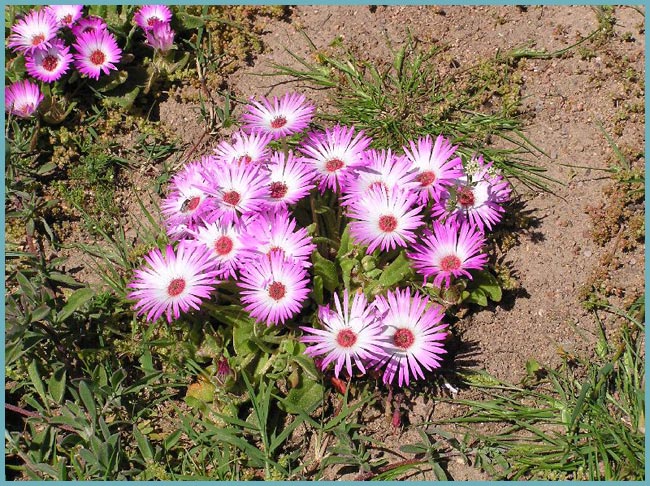

Plant the mesembriantemum in a well-lit area
It is recommended to transfer perennial plants for the winter to a greenhouse with heating or a room in which the temperature does not drop below 5 degrees. When the temperature reaches zero, the mesembriantemum usually dies.
Top dressing is applied twice a month during the summer period.
In general, the mesembriantemum is not susceptible to diseases and is quite resistant to pest attacks. Occasionally, a spider mite can be found on a flower.
When and how to sow crystal chamomile seeds in the ground
In the southern regions, seeds can be sown in open ground no earlier than May, but the midday flower will bloom much later. The emerging seedlings must be thinned out so that the strongest specimens remain. The distance between them is about 20 cm.
African chamomile is very thermophilic, at most it can tolerate zero degrees for a short time. Fragile stems and the destructiveness of low temperatures - these are all the disadvantages of the plant. Otherwise, Mesembriantemum brings only joy. The flower garden containing ice grass is literally transformed.
Description and plant varieties
Mesembriantemum (dorotheanthus) is a perennial ground cover plant from the Aiz family. A small succulent with fleshy foliage and stems can reach a height of no more than 10 centimeters.
Its main charm lies in its beautiful chamomile-like inflorescences and the brilliant shine of the leaves in the sun. Hence the tender nicknames that have taken root among the people - crystal grass, the sun. For those who want to plant a mesembriantemum in the garden, growing from seeds can cause some trouble, but the effort is worth it.
Luxurious green carpet strewn with charming multicolor flowers looks amazing. The inflorescences are quite large, up to seven centimeters in diameter. But bright "suns" open only during the day and in clear weather. At least 50 species have been identified.
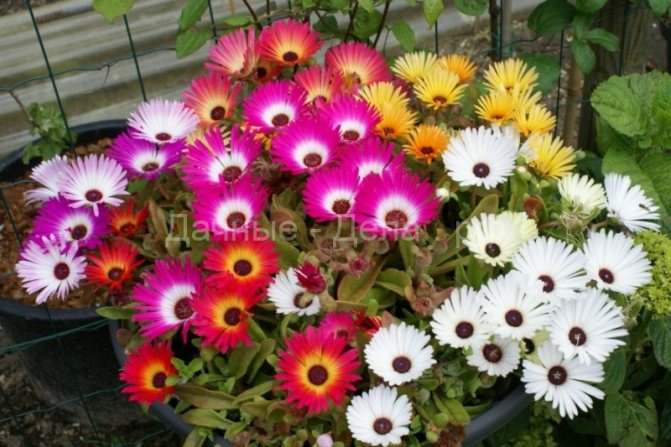

Small copies of daisies can be white, red, light purple, orange, and pinkish.The seeds are just tiny, in one gram there are at least 3000 pieces. You can keep them for a long time, within two years they are guaranteed not to lose germination rates.
Dorotheanthus grows naturally in hot regions: Chile, Africa, Peru, Australia, New Zealand. Therefore, the landing site should be sunny, it would be good on the south side, and the land should be light, sandy loam and well-drained.
Mesembriantemum is often called the most anticipated flower of seeds. It reproduces in this way, however, only residents of the southern regions can sow directly into open ground, and even then not earlier than May. In this case, the emerging seedlings must be thinned out so that the strongest specimens remain, and the distance between them is approximately 20 centimeters.
Varieties
The mesembriantemum has a huge number of species of this plant, which have not been precisely counted even now. Some of the most popular are:
• crystal mesembriantemum (another name is crystal mesembriantemum) - a plant resembling a chamomile, no more than 15 centimeters high, leaves are soft green with wavy edges. The leaves are dotted with glands - papillae, which look like dewdrops. The crystal mesembriantemum can bloom with snow-white, red or pink flowers, which are included in the composition of three-flowered inflorescences;
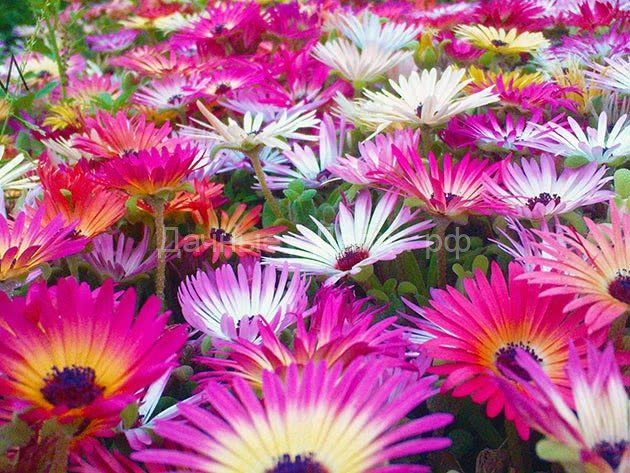

• Mesembryantemum tricolor is an annual flower with a spreading structure, reaching a height of 12 centimeters. The stems are red in color and form a kind of carpet covered with specific hairs. The leaves of this type of mesembryanthemum are linear, just over 3 centimeters, they are completely covered with hairs - papillae. The flowers are pink, slightly more than 3 centimeters in size, and the center of the flower is black;
• mesembriantemum daisy - a low annual plant, about 10 centimeters in height. The shape of the leaves is peculiar, resembles an egg, their length slightly exceeds seven centimeters, they are covered with papillae. There are quite a lot of flowers, their size ranges from 3 to 4 centimeters, and the color can be very different: red, yellow, orange, pink, purple;
• cloud mesembriantemum is a shrub that is an evergreen plant and completely covers the soil where it grows. The height of the flower is low from 6 to 10 centimeters, the leaves are rounded and their length is slightly less than 2 centimeters. With the onset of cold weather, it acquires a bronze color, does not tolerate frost badly, but does not bloom for a long time. Flowers can exist in red, orange, purple, they look like stars, without a stem.
Propagation of the mesembryanthemum by cuttings


Cutting mesembryanthemum photo
The fragility of the shoots is compensated by their ability to propagate by cuttings. The roots of each stem lobe appear very quickly during cuttings.
- in the fall, strong healthy bushes are selected, dug up;
- leave in a dark, cool place until spring;
- stored at a temperature of about + 10ºC;
- divided into cuttings;
- put on rooting in wet sand;
- for three days the cuttings are not watered, then the bottom watering is carefully introduced through the pan, avoiding waterlogging.
- after the appearance of young leaves, they are transferred to open ground (March-May, depending on the climatic zone);
- sandy soil is preferable for planting, the place must be dry and light.
Important: the cuttings like to be capricious, you need to make sure that the water in the area does not stagnate, you need to water it sparingly. Otherwise, decay is possible. After a short period of time, the root system is formed, the plant grows vividly. No crop trim is required.
Diseases and pests of the mesembryanthemum
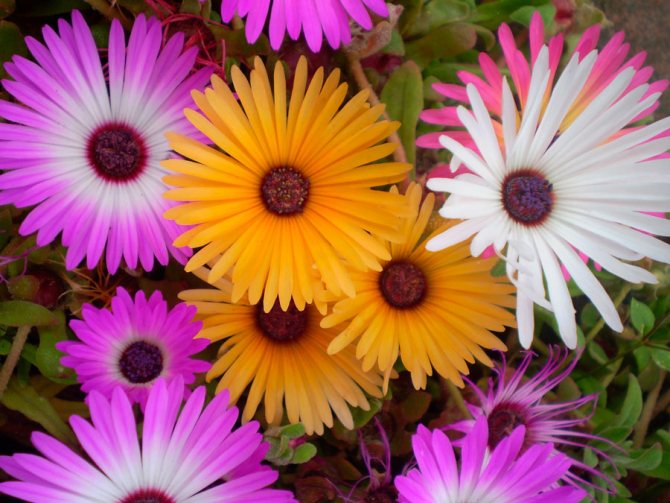

Diseases
This crop, when grown in open soil, has a fairly high resistance to both diseases and harmful insects.Most often, it suffers due to unfavorable weather conditions, or rather, high humidity or due to improper irrigation. If moisture stagnation is observed in the soil, then the bushes can be affected by root rot, while it is almost impossible to cure diseased plants. You can trim off the affected areas of the root system and spray the bushes with a fungicide, but the chances are that this will not help them.
If the bushes are planted in a shaded place, then they may not bloom at all, because they need a lot of sunlight, while direct rays do not harm them at all. If the mesembriantemum lacks light, it will become elongated and take on a painful appearance. Also, bushes become less attractive if they lack the nutrients contained in the soil.
Harmful insects
Spider mites can settle on the bushes, which prefer to live in exactly the same conditions as the mesembriantemum, but these pests can suffer due to high humidity. To get rid of ticks, you need to use acaricides, for example, Aktara, Fitoverm, Aktellik or Akarin.
Mesembriantemum at home
African chamomile can be grown as an indoor crop; varieties Mesembriantemum tiger, Mesembriantemum white echinatum are suitable for this. On the window he prefers only the sunny side.
The growing season requires moderate watering and bright diffused lighting, during the dormant period the plant does without watering, the temperature of the content is reduced to 10-16 ° C. It tolerates dry room air well. On hot days, it requires spraying the space around you. To make the composition luxurious and lush, you need to plant several plants in one container.
Difficulties in indoor growing mesembryanthemum
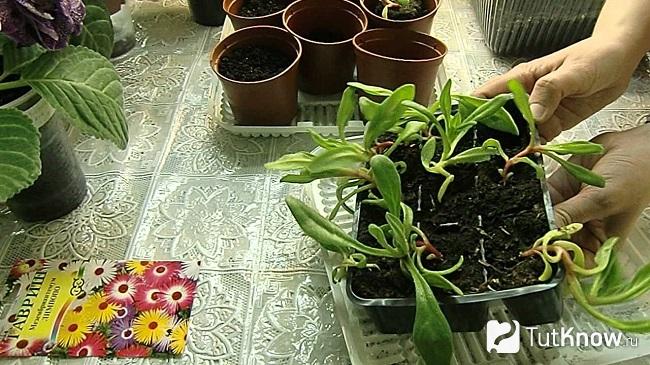

The main problem of the succulent is the spider mite and various rot from an excess of moisture in the soil. In the first case, spraying with insecticides is needed, and in the second, a transplant with preliminary treatment with a fungicide.
When exposed to direct sunlight, sunburn appears on the leaves, if the soil is flooded, the roots begin to rot, the foliage shrinks, and flowering does not continue. After exposure to a draft, the mesembriantemum withers. It is necessary to change the place of the pot with the plant and adjust the watering.
How to care for a crystal chamomile
Mesembrianteum is a relatively rare flower. Seeds are not sold everywhere; gardeners' handbooks rarely mention it. But those who preferred this plant to decorate their garden area will forever remain its adorers.
For Mesembriantemum crystal, no special care is required, it is worthwhile to do with simple rules. The southern visitor prefers slightly alkaline soil, does not suffer from temporary drought, and tolerates heat excellently.
Watering
Waterlogging during a rainy summer, spring frosts can be disastrous - roots rot from stagnant water, and frost destroys the ground part. If the plantings are withering, you should stop watering until the plants recover. Lack of light will lead to stretching of the shoots, flowering weakens. The midday needs a sunny spot. Does not bloom in the shade. When it gets cold, the flowering bushes are wrapped in a covering material, when warm weather returns, the shelter is removed, then flowering will continue.
Top dressing
Care involves the introduction of dressings twice a month - from May to September. If, before the cold weather, the stems of the plant are cut off, taken to the room, flowering will continue even without water, thanks to the useful substances and moisture accumulated inside the leaves.
Wintering
The African flower does not tolerate negative temperatures, therefore, the plants are dug up for the winter, kept without watering until spring in a bright room at a temperature of + 10-12 ° C, or grown as an annual crop.
Planting and leaving
A place for planting a mesembryanthemum should be chosen open to the sun; in this regard, the succulent does not compromise. In nature, crystal chamomile grows in open, dry areas, including the southern rocky slopes. The soil is preferable to sandy and sandy loam, necessarily light, with high-quality aerobic indicators. If you are not sure of sufficient soil permeability, you need to take care of a powerful drainage layer.
The contact of the stems and leaves of the mesembryanthemum with moist earth easily causes them to rot. As a preventive measure, it is recommended to scatter small mild pebbles and river pebbles over the surface of the soil.
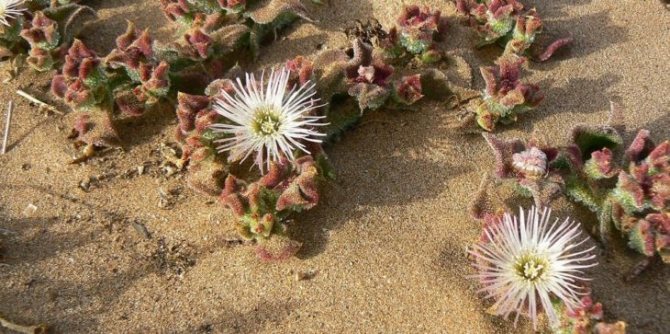

The mesembriantemum does not require laborious self-care, moreover, excessive attention can only harm it. Basic rules to follow:
- The lack of light is critical for this succulent, its stems are ugly stretched, the distance between the leaves increases, and bald spots are visible in the soil cover. In this case, you can not wait for flowering at all.
- Watering the mesembriantemum is necessary only in a hot dry summer, the rest of the time the plant has enough of its moisture reserves.
- Two mineral dressings are recommended per season.
- Adult bushes of crystal chamomile are not afraid of cold snaps to 0C. But winter cold for her can become critical even under cover. Therefore, the plant must either be planted annually, or transferred for wintering to a room with low positive temperatures.
Types and varieties of Mesembriantemum with photos and names
Among the fifty varieties and varieties, the most popular are:
- Hairy mesembriantemum;
- Mesembriantemum ocellar;
- Crystal mesembriantemum.
Mesembryanthemum hair-flowering Mesembryanthemum criniflorum or Dorotheanthus daisy
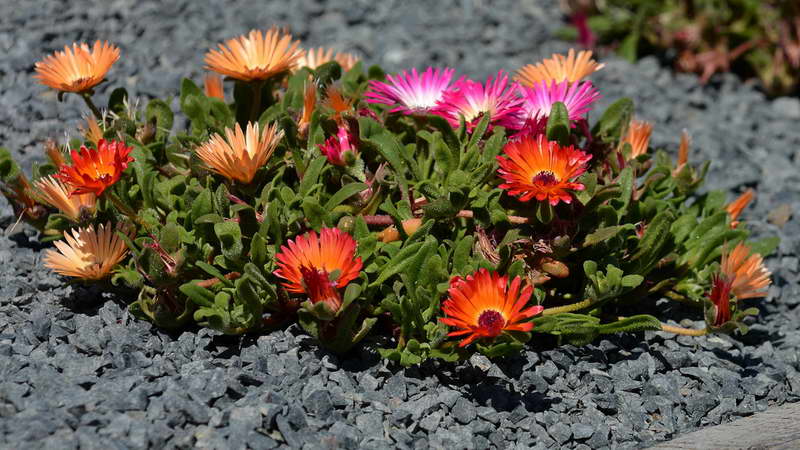

Hairy mesembryanthemum Mesembryanthemum criniflorum photo
The midday plant grows up to 10-15 cm, creeping shoots - up to 30 cm. It has flowers of various colors, up to 3.5 cm in diameter.
Mesembryanthemum occulatus
Yellow-flowered appearance with a delightful red center.
Crystal mesembryanthemum or crystal grass Mesembryanthemum crystallinum
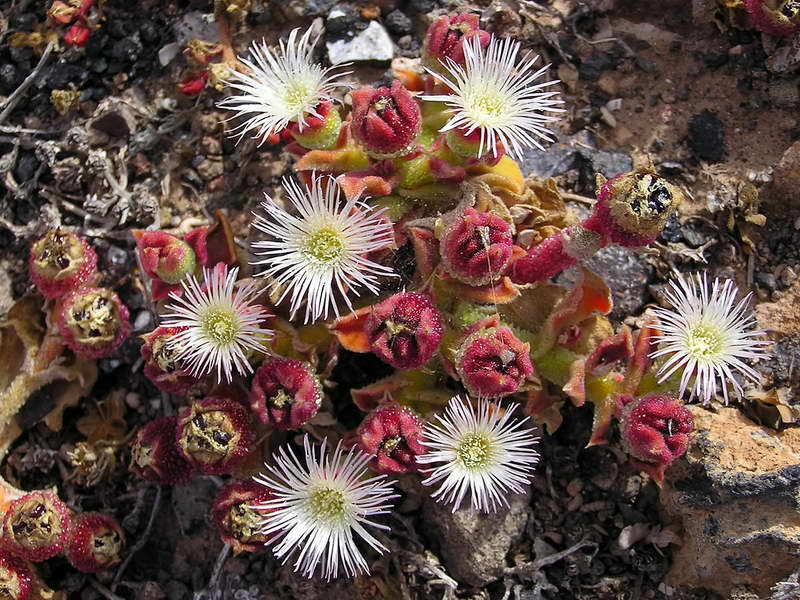

Crystal mesembryanthemum or crystal grass Mesembryanthemum crystallinum photo
The most famous perennial among flower growers. Strong shoots always sparkle with "droplets", therefore both shoots and leaves are very decorative. The tone of the flowers is the most diverse.
Famous varieties:
- Mesembriantemum Limpopo, blooming June - October;
- Hoarfrost variety - one of the rare, bred by breeders;
- Mesembriantemum Sparks with large, up to 4.5 cm, yellow-white leaves, large shoots.
Popular varieties: Lunet, Northern Lights, Apricot pointe shoes, which do not close in cloudy weather.
Main types
According to various sources, there are from fifty to eighty varieties of the genus Mesembriantemum. Not all of them are suitable for cultivation in flower beds - some grow only in the wild. Here are the most popular garden varieties:
- Crystal mesembriantemum is perhaps the most famous species of this plant. It is a short flower, found naturally in the Azores and Canary Islands and on the shores of the Mediterranean Sea. Its flowers resemble daisies with their long and narrow petals, and their hue ranges from white to pink and even red. This species has received many other household names: ice grass, crystallinum, glacier, crystal grass, crystal chamomile. All this is due to the unique leaves of the plant, as if strewn with crystal droplets.
- Mesembriantemum daisy is an annual plant ten centimeters high. It has many varieties with different shades: there are lilac, pink, red, yellow, orange flowers. It closes at night and in bad weather.
- Cloudy mesembriantemum is an evergreen bush up to ten centimeters high with thin and short leaves. Its flowers can be orange, golden or lilac. It is famous for its frost resistance, but it does not bloom for long. Its flowering period begins in late spring.
- Mesembriantemum cereal is an annual plant up to twelve centimeters high. Its branches have many branches, making the flower look unusually thick. The leaves are reddish and fleshy, three to five centimeters long. They creep along the ground, covering it tightly. The flowers have a carmine pink hue.
Mesembriantemum in landscape design
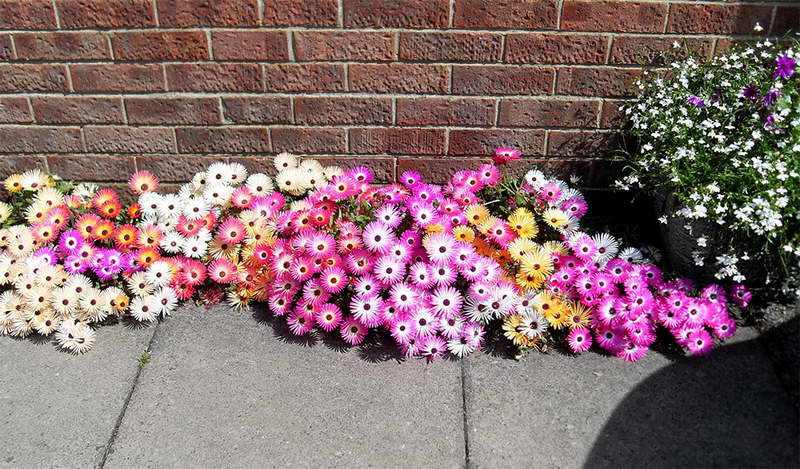

Mesembriantemum in landscape design photo
Mesembriantemum is a real find for decorating a site. Both leaves and flowers have amazing decorative properties. In the shade, the plant can be grown as a ground cover - there will be no luxurious flowering, but the earth will be covered with a carpet of amazing dense leaves with growths in the form of dew drops.
Midday flowers look interesting, so they are often planted in the foreground of compositions. They are used to decorate alpine slides, fences, slopes, artificial reservoirs. Crystal grass is combined with bulbous, corms, tall roses, bells, or used to create monoclumbus. The main thing is not to go too far with the number of colors, they are very bright, "they take the whole look at themselves." Cultivated African chamomile as a container plant to be placed on balconies and terraces.
Important: when forming a flower garden from Mesembriantemum, you should pay attention that there are no blue shades among the whole variety of crystal chamomile. The void will have to be replaced with any other colors with this shade.
Popular varieties
In addition to the species that nature gave people, breeders managed to develop many new varieties. Many of them have been specially created for growing in gardens and therefore are ideal for decorating a backyard. The most popular ones are:
- Mesembriantemum Harlequin is one of the best garden options. Its flowers have an attractive pink-orange color. It is a creeping tall plant with large flowers - up to five centimeters in diameter. With the help of this variety, borders, rockeries, rocky hills are often decorated.
- Mesembriantemum Sparkles is a variety with yellow-white leaves and large flowers, reaching almost five centimeters. They can be of different colors - orange or pink - but they always have a white circle in the center of the bud.
- Mesembriantemum Hoarfrost is a variety bred by Russian breeders. It blooms in bright shades of pink, orange and yellow.
- Mesembriantemum Limpopo - blooms with very bright flowers from June to October.
- Mesembriantemum Lunet is a type of cereal mesembriantemum. Its peculiarity is the red center of the flower, from which yellow petals diverge. Moreover, it does not close in bad weather.
Spathiphyllum flower: transplant and home care
Useful properties of mesembryanthemum
Reviews about the properties of crystal mesembryanthemum vary. On the one hand, there is information about its use in cosmetology and cooking. African tribes cultivate the afternoon tea as a vegetable crop. The leaves stewed with butter are like spinach.
Specialists have isolated an anti-wrinkle extract from crystal chamomile. A miraculous extract cannot be prepared at home by boiling or insisting on flower leaves.
From other sources, Mesembriantemum is a non-pharmacopoeial plant.Due to the content of psychotropic substances, official medicine does not use this plant as a medicinal one. Light doses of water extracts from the stems relax the muscles, contribute to the manifestation of a feeling of mild euphoria. Significant dosages can provoke the appearance of visions, hallucinations, therefore, the afternoon tea is used by the indigenous peoples of Africa for ritual purposes. For this reason, several states in America have banned its cultivation by law.
Description
Typically tall plant does not exceed 15 cm... It is of two types: creeping and creeping. A special group is formed by mesembryanthemums of the semi-shrub type.
- at the stage of ripening, small seeds are formed in the capsules. Stems grow in the form of branches that spread along the ground;
- the leaves have a characteristic green color for their family, they grow round in shape. In the upper part of the plant, the leaves go in a queue, and in the lower part in the opposite order. One of the main features is the presence of superficial swollen cells that resemble crystal drops.
- mesembryanthemums have double flowers that look like daisies; They differ in a wide color palette, which can include both white and red shades. The plant begins to bloom in early summer and until mid-autumn.
Glass chamomile in rock garden and rocky garden
An alpine slide, where this flower predominates, may well become the central composition on the site. Flowers of fantastically bright colors against the background of stones of any shape and size (large pebbles, boulders, granite blocks) are simply eye-catching. Not only the rock garden, any rocky garden where the dorotheanthus grows will be in the spotlight. Only dorotheanthus of various colors can be used on an alpine slide; combinations with other plants can be created.
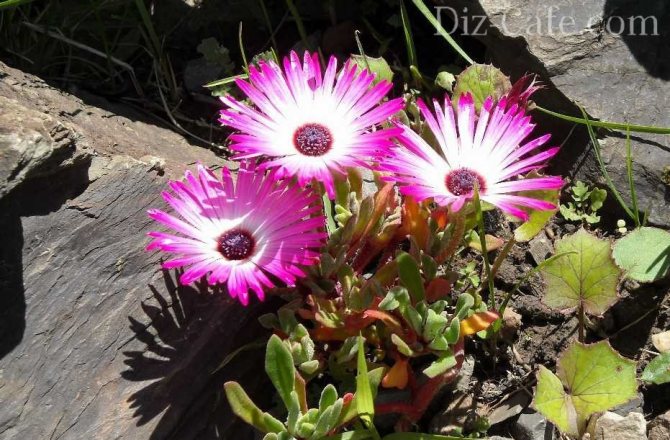

Fragile, delicate and bright glass chamomile in the rock garden looks very impressive against the background of stones. The plant is unpretentious - it is enough to place the rock garden in the sun, and the dorotheanthus does not like abundant gravy
If you put gravel, rubble or small pebbles under the leaves of the plant, it will feel better, because a layer of stones will protect the leaves from the damp earth. Leaves with droplets, bright flowers against a stone background already form a spectacular composition. Dorotheanthus blooms from mid-July to cold weather, but even when there are no flowers, the leaves perform the decorative function. If you like unusual shoots of the plant, it can be used as a ground cover in shaded plantings.


Bright bushes of dorotheansus against the background of rubble and stones. The plant can be planted in groups in a gravel garden, placing interesting color accents, and in a rock garden you can use it with any stones
Planting mesembryanthemum
Mesembriantemum can be propagated vegetatively and using seeds. The first option is quite simple to do at home. In the autumn months, it is necessary to select strong bushes. They must be healthy and strong. They need to be divided into cuttings and stored in any room with a temperature of about 10 ° C. In the spring months, they can be moved outdoors. The choice of the month depends on the weather and climatic conditions.
Cuttings can rot, so it is very important to ensure that there is no stagnant water in the area. Watering should not be too abundant. After a while, a root system will begin to form.
Growing from seeds is also a very popular method. You will need to do the following:
- It is necessary to mix the sand with the soil to make the substrate loose and light. Moreover, you need to take more sand than earth. The river is best suited, but before use it is supposed to be calcined in the oven to prevent unnecessary microorganisms from entering the soil mixture.
- Seeds are usually sown in March or April in small seedling containers.Moreover, it is supposed to sow superficially, since the seeds themselves are very small and light in weight. By the way, they are distinguished by good germination. They need to be planted in fluffed ground. It is prohibited to deepen.
- Then cover the containers with transparent film. Seedlings will be noticeable in a week, but you will have to wait about a month for all the seeds to sprout. Until this time, the temperature should be approximately 12-15 ° C.
- When all the seedlings appear, then their containers are supposed to be put in a place with good lighting. Watering the seedlings should be done in moderation. Their roots should not be allowed to rot in the ground. The temperature should be reduced to 10 ° C.
- When the seedlings grow up, they need to be dived, that is, placed in different pots. This will slow down the growth of the plants, so it is best to plant only a few seeds per container in the first stage.
- It is possible to plant on a permanent site only after the weather is established without night frosts and the soil warms up. As a rule, this is May. It is advisable to keep the distance between the seedlings at least 15 centimeters. For some varieties, you need to leave a space of 30 square meters. see if they have long shoots. It is best to choose a sunny location. The slopes on the south side are perfect.


